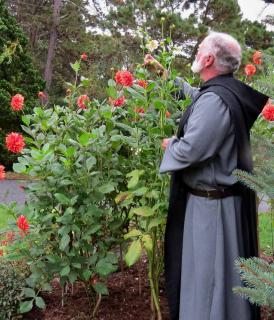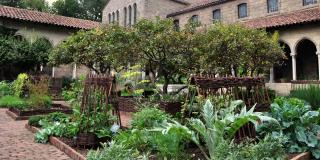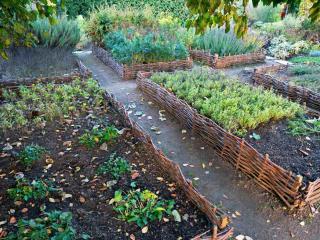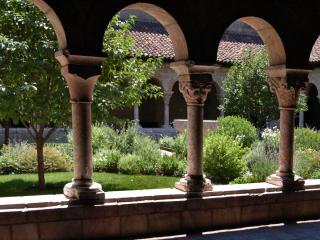

Wisdom and ancient charm abound in the cloister garden of old. It somehow recaptures a bit of the lost garden of Eden.
How can one recreate this quaint atmosphere?
A cloister garden is a type of garden design that is very versatile. It’s practical, down-to-earth, and easy to care for, and it also answers all our needs: food, beauty, and spiritual growth.
Similar to a square-foot garden, it brings together flowers, fruits and veggies. Short work sessions make tending for it simple!
 Usually set right next to the house where the church pastors or priests would live, this garden had to answer the many needs of persons living there. There is a hodgepodge of vegetables, flowers, fruits and medicinal herbs. This organized randomness actually brings on the spirit you’re trying to create. Cultivated plants are set along square plots or growing beds surrounded with boxwood or thyme.
Usually set right next to the house where the church pastors or priests would live, this garden had to answer the many needs of persons living there. There is a hodgepodge of vegetables, flowers, fruits and medicinal herbs. This organized randomness actually brings on the spirit you’re trying to create. Cultivated plants are set along square plots or growing beds surrounded with boxwood or thyme.
First, draw your beds out with a spade or a bit of string. Ensure all the plants you grow stay within reach: mark out small beds. If ever you’re lucky to have a wall to a side, grow nasturtiums or sweet peas along a lattice attached to the wall. Here and there, plant some hollyhocks and sunflowers at the foot of which you’ll grow wallflowers and gaillardia. Don’t forget to plant red currant, black currant and raspberry bushes, too.
Between rows of vegetables, sow Italian everlasting and forget-me-nots. Plant a square of herbs and spices with mint, common vervain, sage, savory and garden angelica. You can also try to grow absinthe, a beautiful hardy plant, but it grows quite tall so you’ll have to give it space. Favor ancient heirloom vegetables: tetragonia, pattypan squash, chard…
 An essential goal of the cloister garden is to induce introspection. In a corner, facing a growing bed, you can place a bench to sit down on and relax. A stone bench is ideal, but wood benches such as those found in parks are also nice.
An essential goal of the cloister garden is to induce introspection. In a corner, facing a growing bed, you can place a bench to sit down on and relax. A stone bench is ideal, but wood benches such as those found in parks are also nice.
Landscapers that are keen on creating the feeling of olden times offer zinc watering cans and basins that are leak-proof. If original vintage pieces can’t be found, replicas are often available and also look very nice.
Hovering above one of the walkways, an iron hoop can host a climbing rose tree or honeysuckle vine. Walking under these plants will provide solace to the restless soul!
A simple tool shed will be very useful and, if well-chosen, can match the surroundings well.
 Set permanent hoops up along the growing beds so that you can protect your seedlings with a greenhouse tunnel or cold frame. Under the roof water spout, place a rainwater drum to collect soft, pure water. If ever you’re lucky enough to have a well nearby, grow clematis around the pulley.
Set permanent hoops up along the growing beds so that you can protect your seedlings with a greenhouse tunnel or cold frame. Under the roof water spout, place a rainwater drum to collect soft, pure water. If ever you’re lucky enough to have a well nearby, grow clematis around the pulley.
Along walkways and paths, place terra cotta plant pots and grow lavender and geraniums inside. A wrought iron fence will immediately throw your visitors back a couple centuries!
And, if your garden is large enough, a body of water like a round basin will add a refreshing touch.
 Many ancient cloister gardens subsist on the Old Continent. Europe has indeed been home to many monasteries. To this day, a few noteworthy ones are worth visiting:
Many ancient cloister gardens subsist on the Old Continent. Europe has indeed been home to many monasteries. To this day, a few noteworthy ones are worth visiting:
Note that cloister gardens are often associated to monasteries of the Catholic faith. Other civilizations have similar garden styles with a spiritual touch, from Islamic walled gardens to Japanese Zen gardens.
A. G.